Much has been written and lauded about this year’s SPX, and I’m late to the game but I have a few thoughts I wanted to put to pixel before the memories fade. It was a great time for just about everyone, I think. I had a blast at TCAF this year and came away from it completely optimistic about The State of Comics. That mood was only deepened by SPX, and I don’t expect it to fade any time soon. A few little notes:
¶ I drove down with a wonderful crew consisting of Carol Burrell, Colleen AF Venable, Robyn Chapman, and John Green. You couldn’t ask for better company. Carol, in particular, has carved out her own little kingdom at Lerner Books, editing and translating comics for kids while she still somehow manages to work on her own webcomics. She’s incredibly humble…but one of the coolest people I know in comics. As on so many SPX car journeys, the hours breezed by with jokes and songs and coffee and gossip. Over lunch, we asked John what it was like to be a man in comics, and were astounded by his revealing answers.
¶ Once I arrived in Bethesda I found myself whisked away to Washington, DC for an episode of Literary Death Match. You can read all the details here. The event was held as part of the Association of American Editorial Cartoonists convention. and I soon found myself surrounded by Pulitzer Prize winners—some had more than one even. The trip to DC itself was a thrill; as a political blog junkie I was excited to find myself actually walking on K Street and traipsing around Foggy Bottom. I don’t even know what that means but I was there!
The above photo shows the lineup for the event: two-time Pulitzer winner Gene Weingarten, the one and only Dean Haspiel, Keith Knight, Pulitzer winner Mark Fiore, Mother Goose and Grimm’s Mike Peters, and Herblock Prize finalist Jen Sorenson. I was truly not worthy. Host Adrian Todd Zuniga kept things moving right along and the evening proved one astonishing fact: both Knight and Sorensen can draw Dean Haspiel with their eyes closed!

Afterwards it was burgers and brews with much of this crew, joined by Joe Infurnari, the Beat’s new stalwart Hannah Means Shannon and the NY Times’ staff cartoonist Brian McFadden, or as people call him, “that guy!” Blogger Emily Whitten and two very smart guys whose names I didn’t write down also joined us for a sparkling evening.
When it comes to editorial cartoonists, I’m mostly a fan, so I tried to just soak in the experience of being in the nation’s capital with the people who skewer it. A memorable night indeed.
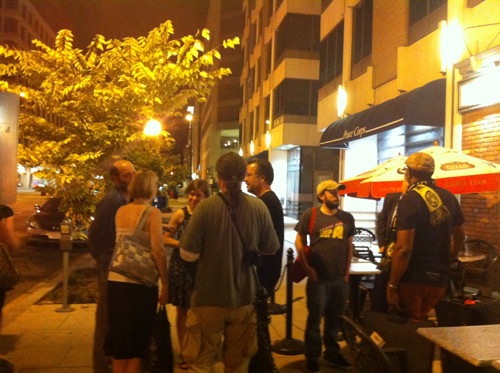
¶ Back at the Marriott HQ, we were treated to the experience of seeing Clowes, Ware, Los Bros, Tomine, Burns and more just hanging around in the bar. Just chatting and drinking like regular folks. Imagine it! It was a late night of talking and even arguing a few times, capped off by sitting around with Sean Pryor and Ulises Farinas as a recently-divorced fellow from Morocco who didn’t seem to have any reason to be at the show told sad stories from his life. That was probably the bizarreness highlight of the weekend, but everyone bonded over head scratching memories of it the next day. Also, I think Sean and Ulises tied with Renee French and Jen Vaughn for Best Hair Of Show.
¶ The next day all the magic unfolded in earnest. And yes by magic I do mean lots of people spending lots of money on awesome comics by some of the greatest cartoonists in history. People were shocked by the depletion of their pocketbooks, but in a very good way. I’ve already written about the “Publishing During the Apocalypse” panel, which was anything but apocalyptic. In fact, in my many many years of covering comics, I’ve been on many publishing panels, and usually the hopes for future success revolve around finding a penny on the sidewalk.

That is no longer the case. We experienced a weekend that saw cartoonists at the Library of Congress and the Smithsonian and at bookstores and in libraries, and speaking in packed rooms where everyone asked intelligent questions. I don’t think this was a rare aberration, but the way forward.
After my panel I went to see Gilbert Hernandez speak and then Mark Newgarden’s Cartoonists and Comics On Camera, Reel One: 1916-1945. Although all of the panels were amazing I felt confident that I’d be able to to see many of them online eventually, however Mark’s revealing film festivals are only experienced in the moment, and I didn’t want to miss this. I wasn’t disappointed as we were given bizarre snippets of film; if they’d had YouTube in the 30s this is what it would have been. The highlight was a short called “People on Paper” that showed Milton Caniff drawing in his smoking jacket, as well as other ’50s comic strip artists lounging around their beautifully appointed homes. There was another film that was remarkable, but I need to get the title from Mark before I write about it.
It was obvious as it unfolded that Saturday was a record-breaking day for the show. At 12:30 I went to the hotel coffee bar to get some fuel, and overheard the barrista remarking on how much money they had made., “It will be one thousand four by your shift—it’s already one thousand two!” she said with excitement. Yeah it wasn’t just the ATMs and Fantagraphics that were humming…SPX runs on coffee.
¶ It’s worth pointing out, as I do every year, that the Ignatz Awards are the only comic book awards that people hurry back from dinner to attend. Luckily they were held an hour later, so I could enjoy a warm meal in a convivial setting for the first time since the move to Bethesda North. As usual, the room was packed. This year’s host, Jerzy Drozd, presented a pro comics slideshow that was perhaps not necessary given the crowd, but no one was complaining. Others have noted that the presenters were a mix of familiar—Nick Abadzis and Jaime Hernandez—and people you had to check on Google, but with only a few awards to hand out, the Ignatzes breezed by.
The casualty of the extra time for dinner for me was the chocolate fountain! Viewing the long line for the fountain, I tarried in a long, fascinating conversation with Françoise Mouly about the progress of her outstanding Toon Books imprint, only to find when I was finished that the fountain had been retired!!! Apparently there was an equipment failure of some kind. I decided that I would content myself with leaving a Hershey bar in a hot car sometime—chocolate is everywhere but long conversations with Françoise Mouly are not.
That evening’s patio patter was the most crowded I’ve ever seen. It’s always a lively evening but no one wanted to go to bed or move the party to a room. It reminded my of TCAF’s Saturday rooftop party—both rank as my comics highlights of 2012, great evenings of people you don’t always get to see in a great mood and eager to talk about everything.
Despite that I did end the night in a late room party and let’s just say I boosted the hotel coffee bar’s take by quite a bit on Sunday. I decided to forego half the Chris Ware panel (which I know will be online) for Ryan Holmberg’s Disney and the Making of Postwar Manga: The Case of New Treasure Island, which was 45 minutes of heady comics history. Holmburg, whose unique knowledge of Japanese comics makes him a one man Wikipedia entry, is planning an article for The Comics Journal on the topic, but here’s the short version: New Treasure Island by Osamu Tezuka and Sakai Shichima is generally considered the most important comic in manga history, a Birth of a Nation which changed the way manga was created and read. However, Holmburg presented side by side panels showing that it was directly influenced by Carl Barks’ Donald Duck Finds Pirate Gold and other Disney works, including Floyd Gottfredson. While this isn’t exactly a shock, his findings have been met with shock in Japan. It’s not a put down of Tezuka—just an acknowledgement of how different comics cultures have influenced one another. Holmburg reports there was a signed picture of Barks in Tezuka’s office…I like to think they met at a San Diego some time…maybe not historical but that can be my little fantasy.
Then I caught the rest of Ware’s panel. Like the other special guests, one thing that comes across hearing Ware speak is now NICE he is. And also, considering his often painfully awkward early interviews and public appearances, it’s wonderful to see how he’s become such a riveting and amusing speaker. I then caught the Life After Alternative Comics panel where Bill Kartalopoulos skillfully led Clowes, Los Bros, and Tomine through a history of alternative distribution and expression from 1980-1995.
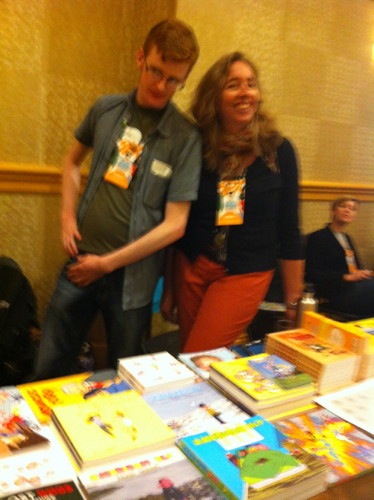
After that it was pretty much time to wrap things up, spend the last bits of money and go. It is safe to say that the overwhelming feeling was a fuzzy, happy one.
¶ Mucho props to show runner Warren Bernard. He inherited a smoothly running show from previous directors and managed to take it to the next level by adding strong promotion and tying SPX to the community and the local institutional infrastructure. Everyone needs to look at what he’s done, and what Chris Butcher has done with TCAF and figure out how to make it work in their own locales.
¶ Likewise, programming director Bill Kartalopoulos always does a great job and this time he knocked it out of the park. It wasn’t just spotlight panels for the titans, it was having many voices, some familiar, some new, in exciting and provocative mixes. Every panel had something new to say.
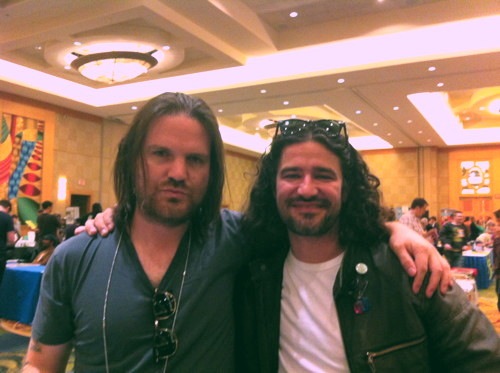
¶ I had many conversations about bodies of work. When he won an Ignatz, Jaime Hernandez exhorted the crowd to “keep making comics” and I think that is a big part of why comics are booming now. The last decade of graphic novels and indie shows have allowed cartoonists like Nate Powell and Jeff Lemire and Julia Wertz to produce bodies of work. It was Box Brown who noted that every time he put out a new book, sales of his old books increased. It’s a no-brainer equation but the audience and infrastructure now exists to support working on a book for a year. Los Bros, Clowes and Ware all came up in an era where a regular comic was part of the equation. People told me the pamphlet is coming back in some ways, but the truth is there are multiple ways to get your work out there, and most important, there’s an audience that follows authors. The support structure is leaving more room for creativity instead of wondering how the hell you’re going to get your book out there.
¶ That said, not everyone is going to have a shelf full of books as an end result. Even old-timers kept remarking on how many people they didn’t know, and the turnover at every SPX is notable. There are many familiar faces from even five years ago who aren’t around any more. And that’s okay. Just as putting out a 7″ single was a thing for one generation, putting out a comic is now a thing that some people do at a certain young point in their lives. Some of them are just going to pull out a shoebox someday and tell their kids, “Hey, see I used to draw comics.” And some of us, separately, are going to pull out those 7″s and minis and say “This was really good.”
¶ There was no karaoke. Whether it’s just because all the nearby karaoke places closed or because that was something they did in the Aughts, I’m not quite sure. I do know that drinking was more popular than at some past editions of the show. On Sunday morning one I overheard one cartooner at the coffee stand saying, “Dude, I still have the rum vomits. I don’t think I can drink anything.”
¶ Even some wags who never cottoned to the “Team Comics” vibe of pig-roast era SPXs were heard talking about “Camp Comics.” There is a large faction of the indie comics crowd that loves it for the twinkly, sparkly family feeling that tends to take over. At the top of this post, there’s a photo of Sean Collins with four of the greatest living cartoonists, all of whom came of age at a time when self-loathing, in the Crumb vein, kind of came with the territory. The new kids don’t have that kind of comics-specific self-doubt, or at least not as much.
On the car ride home, I happened to spot this tweet:
Sitting on the bus thinking of how @emilywernet found a secret slot full of drawings #spx twitgoo.com/66ypdz
— Rebekka R. Dunlap (@RebekkaDunlap) September 16, 2012
I happened to know what she was tweeting about. As I went to the 7-11 on Sunday to get some cash (the ATMs long ago having run dry), I saw a loose brick on the sidewalk just outside the hotel, a few people bending over it. It seems that someone had noticed it, pulled it up and put some mini comics under it, and replaced the brick. As more people found it, they also added to the secret treasure trove. As I left for the last time I saw a mother with her daughter poring over the comics.
It was a sweet, magical way to end a sweet, magical weekend. Some people are going to create a Palomar or win a Pulitzer. Some are going to hide some minis under a brick for a passerby to find. It’s all comics, and it’s all good.


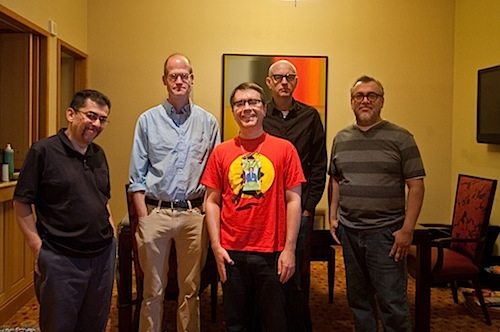
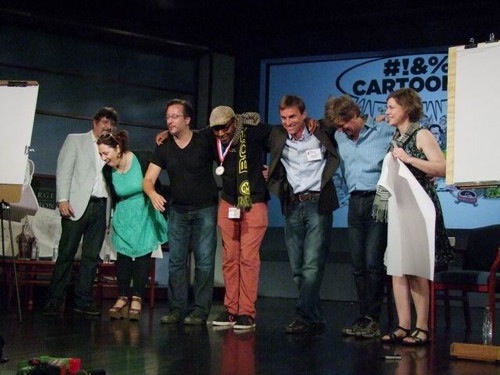
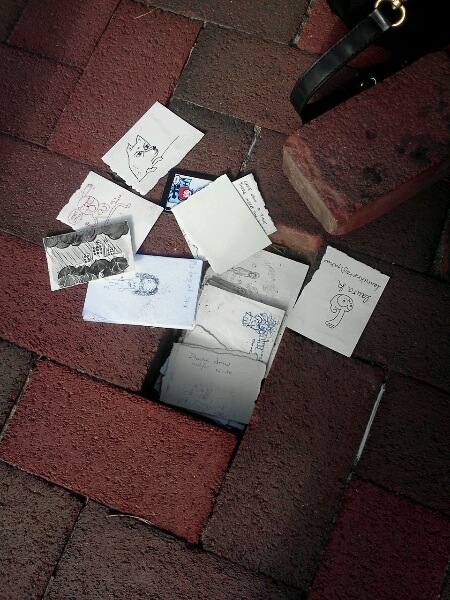

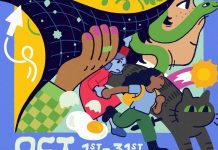



Hidden comics under the brick is beautiful.
I saw that same (?) mother and daughter as I left late Sunday afternoon, and was kicking myself for not getting a photo of them. Thanks for this, Heidi! It really was the final magical capper of an amazing weekend.
Good times. Somehow I never ran into you, but I’ll put a copy of the Digestate anthology I had set aside for you in the mail.
We placed the first drawing and blank paper under the brick at the end of the day on Saturday. We checked back Sunday morning and were delighted to find people had noticed and left treasures. Checking back at the end of the day we were overwhelmed to find such a treasure trove. How wonderful to have spent the day in the company of so many people curious enough to lift a loose brick. It is something we first started doing in Australia and until SPX have only found treasures we have left for each other. xo Kara and Esme (aka mother and daughter at end of day)
Comments are closed.